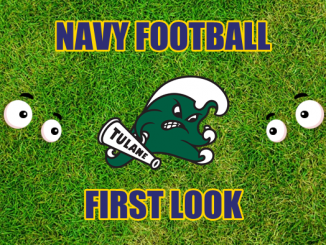
Academy football roundup: departments of defense reign for Army and Navy
The service academies defend the United States. These days, the service academy football teams are depending on their defensive units to win games. It’s not always how things work, but this is how the 2020 pandemic season is unfolding in Annapolis and especially West Point.
Another Saturday has come and gone, and as the season develops, the defenses for Army and Navy are establishing themselves as the backbone groups for these two teams. This isn’t just a reflection of where the 2020 Black Knights and Midshipmen stand; it’s a measurement of the defense-versus-offense balance on these teams compared to the recent past.
Not that long ago, Army was hanging 70 points on Houston in a bowl game. The Black Knights developed their triple option to a point where they either scored at a very high rate, or kept the ball so long that their defense wasn’t overexposed.
Not that long ago – last year, to be precise – Navy had Malcolm Perry, the latest in a line of slick, polished field generals who could run coordinator Ivin Jasper’s offense with supreme potency. Perry took the baton from Keenan Reynolds, who stood on the shoulders of earlier Navy greats such as Ricky Dobbs and Kaipo-Noa Kaheaku-Enhada. Navy, under Perry and his elite predecessors at quarterback, was well-positioned to win 48-45 shootouts.
This year, the Army and Navy offenses can still control the ball and keep it from the opposition, but the maximum potency of the triple option doesn’t quite exist… or if it does, it hasn’t truly emerged just yet.
Army has scored 42 points against an FBS opponent this year (Middle Tennessee), but that point total coexisted with a shutout pitched by a defense which kept getting the ball back to the offense in good positions. Similarly, another high point total for the offense against an FBS foe (Louisiana-Monroe) was accompanied by a brilliant defensive performance which allowed the offense to wear down an opposing defense in the second half.
In the past four weeks, Army’s FBS point totals have declined, with Cincinnati’s quality partially – but not completely – accounting for that drop. Army scored only 10 against the Bearcats, but then managed only 14 against an FCS foe from The Citadel. That alarmingly low number of points created cause for concern heading into San Antonio. Fortunately, the offense picked itself off the canvas and improved.
In the big picture, though, this game still came down to Jeff Monken’s defense and its continued ability to carry the day.
Army’s offense did need to improve by leaps and bounds from The Citadel game in order to beat UTSA, and that’s what happened. Rushing yards: doubled. Third-down conversions: 6 of 10, up from 3 of 13 the previous week, leading to 33:29 of possession compared to 29:09 versus The Citadel. Those were crucial improvements, and they all played a part in the 28-16 win in the Alamodome. Army’s offense also responded to a UTSA fourth-quarter touchdown by scoring 79 seconds later to restore a two-score cushion. Army’s offense was certainly better, and that mattered.
Yet, the day still belonged to a defense which hasn’t had a single bad game this year.
The offense is still immersed in a process of trying to unearth its best self; the defense has been at its best from Day 1 in 2020.
Army stopped two separate UTSA drives which traveled over 50 yards. The Black Knights allowed UTSA to move the ball at times, but the Roadrunners didn’t hit the big play – something Army knew it needed to focus on in this game – and they didn’t finish drives – only one in the second half, not nearly enough to prevail. Army guarded its own third of the field with airtight quality and resolve. The offense did its part, but everyone knew which side of the ball dictated the flow of play and shaped the contours of the contest.
Army knows its offense is capable of improving, as demonstrated on Saturday, but the West Point locker room knows the defense is the straw that stirs the drink for the 2020 Black Knights.
It is similar for Navy this year. The Midshipmen walked off Tulane with a field goal earlier in the season; that specific detail was just like the 2019 encounter against the Green Wave, but the difference is that whereas the 2019 game was a 41-38 shootout, this year’s edition was a 27-24 game with a lot fewer offensive outbursts. This is life for Navy in 2020: Games which would have been played in the 40s or very high 30s in past seasons are now played in the 20s.
Last year, Navy needed Commodore Perry to lead the offense through the stormy seas of college football Saturdays. This year – a transitional year at the quarterback spot – the defense plainly needs to carry a much larger share of the workload.
In AAC play, the Midshipmen haven’t yet allowed a 30-point game, and that’s the main reason Navy is 3-0 in conference play.
Last year, allowing 32 points in a conference game would have been enough to help Navy win consistently. Navy went 9-0 last year in the nine games in which it scored 33 or more points.
This year, had the Midshipmen allowed 32 or more points in all three AAC games, they’d be 0-3 in the conference and wondering how everything went wrong.
The defense carried the Mids through Saturday’s 27-23 win at East Carolina. Though Navy committed two turnovers and managed a modest 318 yards – with only 30 passing yards and a lack of big downfield plays – the defense was able to say, “We got this.” Navy’s defense took away the ball twice, and forced ECU to kick field goals on four separate drives inside the Navy 25. One of those four field goals was blocked by the special teams unit, a crucial play in a game decided by four points. Navy reached its “get six” combination of defensive stops, three-and-outs, and forced turnovers. When the Midshipmen get six of those in any collection, they win. That is once again the benchmark for a winning Navy day.
Secretaries of defense? Ministries of defense? Whatever you want to call it, Army and Navy are winning primarily with defense, not offense, in 2020.
Navy has a much tougher challenge than Army does this week. Navy faces a good Houston team which almost knocked off unbeaten BYU this past Friday. Army faces FCS foe Mercer as a lead-in to an off week and then the likely Commander-In-Chief’s Trophy-deciding game against Air Force on Nov. 7. Regardless of opponent, however, expect defense to set the tone for the Midshipmen and Black Knights. The seasons when Saturday shootouts were expected – and even desired, in some cases – don’t apply in 2020.




Be the first to comment